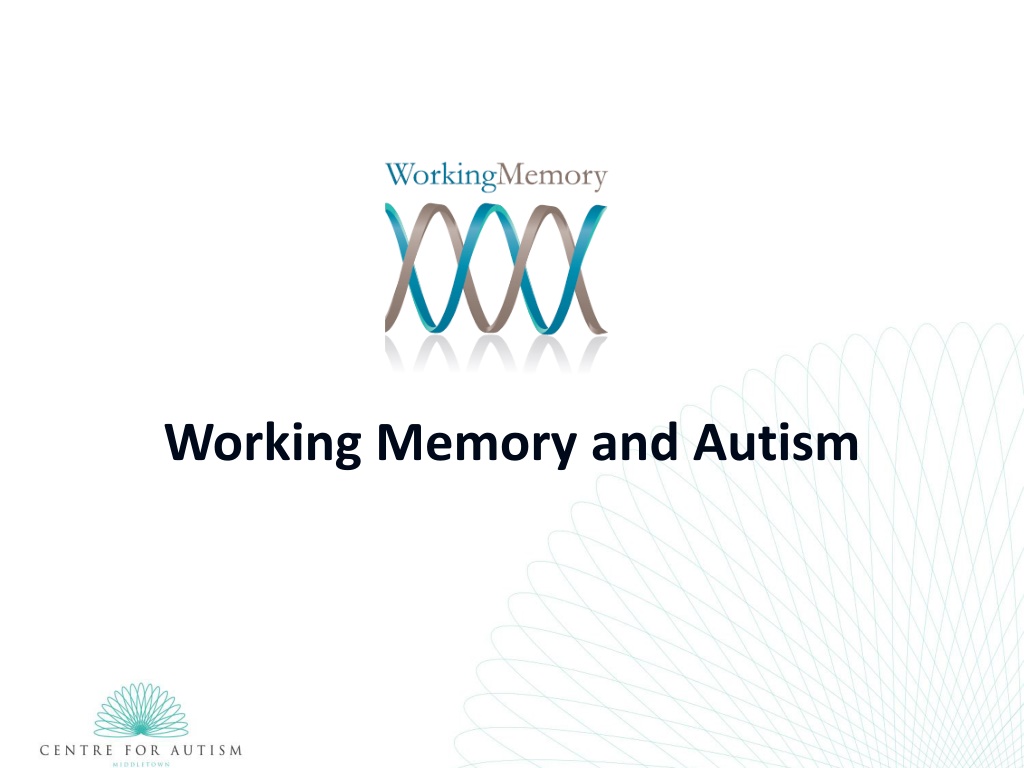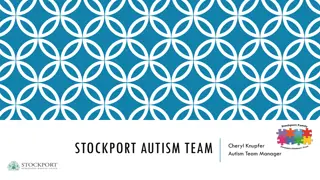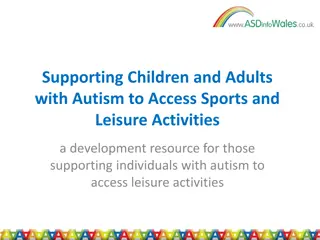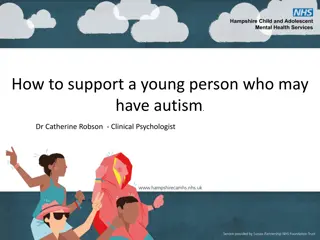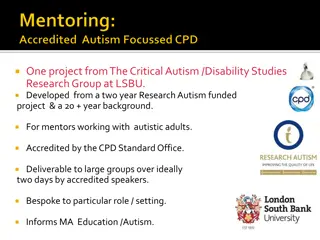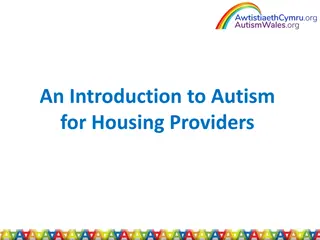Understanding Working Memory Challenges in Autism Research
This research aims to investigate working memory (WM) difficulties in children with autism compared to typically developing peers. By assessing WM early, interventions can be implemented. The study involves tests on verbal and visuo-spatial working memory and observations on digit recall and visual-spatial memory. Ethical approval was obtained for the pilot study involving 56 children. The findings will contribute to understanding and supporting individuals with autism.
Download Presentation

Please find below an Image/Link to download the presentation.
The content on the website is provided AS IS for your information and personal use only. It may not be sold, licensed, or shared on other websites without obtaining consent from the author. Download presentation by click this link. If you encounter any issues during the download, it is possible that the publisher has removed the file from their server.
E N D
Presentation Transcript
Why conduct this research? By assessing Working Memory (WM) at an early age in school, children with such difficulties can be identified and given the opportunity for early intervention. A review of the literature has indicated that WM has been studied extensively in the typically developing population but there has been little research with the population of autism.
Background - Research Study Pilot Study 56 children with and without autism. Aims of the research: To examine whether children with autism have difficulties with WM compared to their typically developing peers. Ethical Approval from Office for Research Ethics Committees Northern Ireland (ORECNI) August 2011 Dr Tracy Packiam Alloway
Tests Verbal Working Memory Listening Recall Verbal Short term Digit Recall Visuo-Spatial Working Memory Spatial Recall Visuo-Spatial Short term Dot Matrix www.pearson-uk.com/AWMA
4 Assessments & Informal Observations
Verbal short-term memory: Digit recall 839251 839251 1. Hear a sequence of digits and attempts to recall each sequence in the correct order. 2. Block of 1 number to a block of 9 numbers. 3. To receive a correct score for each trial, each number must be recalled in the correct order. www.pearson-uk.com/AWMA
Digit Recall Informal Observations Understanding by both groups. Despite the task being dependent on auditory processing, this is a task which is regularly performed in class. apps on their computers and mobile phones. Children from both groups appeared to have developed the skills of recalling digits. Some children with autism spent a great deal of time between hearing the digits and recalling them. They were given the time required to process what they had heard. Other children with autism found it difficult to focus and concentrate after doing practise trial. Given a break if required.
Visual-spatial working memory: Spatial Recall Same/ different 1. 2. 3. 4. Two shapes, shape on the right has a red dot above it. Identify whether the shape on the right is same or opposite. Shape with the red dot could be rotated. End of each trial, recall the location of each red dot on the shape, in the correct order, or by pointing to a picture with three possible positions marked. Block 1 set up shapes increasing up to Block 7 sets of shapes Score for correctly identifying whether the shape with the red dot is the same or the opposite of the shape on the left. The Processing score. Also receive a score for correctly recalling the position of each dot in sequence. 5. 6. 7. www.pearson-uk.com/AWMA
Spatial Recall Informal observations Obvious differences between the control group (typically developing) and the experimental group (autism). Children with autism found this task more difficult than their peers. Two step process -Dependent on auditory processing skills. Used the practice time to gain understanding-lengthy-lost focus Children with autism were given more time to process instructions Focused on voice over -Repeated Even though it moved around Focused on the shape It looks like an Axe Said Not opposite instead of same Gave automatic responses without focusing on the shape
Spatial Recall Informal observations Overload of information- instructions lengthy. As tasks became more complex informal observations showed that some children found it more difficult to engage in the task at hand. Strategies Hands on knees , feet firmly on floor (visuals) Explained using visual cues same and opposite e.g. books, pencils, rulers Repeated voice over instructions slowly using First and Then
Verbal working memory: Listening Recall banan as have teeth false cha irs lay egg s false eggs, teeth 1. Series of individual sentences -true or false. Recall the final word of each sentence, in the correct order. Block of 1 sentence and increases to a block of 6 sentences. Two scores. A score for responding true or false correctly- Processing score. A score for recalling the final word in each sentence correctly. 2. 3. www.pearson-uk.com/AWMA
Listening Recall- Informal observations Children with autism found this task more difficult. Dependent on auditory skills. Fidget, swinging on chair, yawn less focused Two step process Children with autism required more time to process the information given Instructions repeated Some children would have grasped the concept when 1 sentence was called out but when they had to remember the last word of 2 sentences, proved more difficult.
Listening Recall- Informal observations For some children with Autism some sentences were amusing more memorable for example Bicycles have ears, Mice play music , bananas live in water . Children with Autism gave detailed responses to sentences for example Glass is sharp Explanation glass could be sharp when it is broken but not sharp when it was not broken, therefore the statement could be both true and false. TD children appeared more aware of their successes- raising a hand in the air saying yes!
Visual-spatial short-term: Dot matrix The individual is shown the position of a red dot in a serious of four by four matrices and attempts to recall the position by tapping the squares in the computer screen. Test trials The test begins with a block of 1 dot and increases to a block of 9 dots. Scores In order for an individual to receive a correct score for each trial, each dot must be recalled in the correct order.
Dot Matrix-Informal observations This is a visual memory test. Change in body language Sat closer to the screen, appeared more focused. Performance of some of the children with autism was not dissimilar to their same-aged typically developing peers. Visual More a game Computers and phones
Analysis The results were analysed using both a multivariate analysis of variance (MANOVA) and also an analysis of variance (ANOVA). The main findings are as follows
Results-Summary When the 6 WM scores are combined into 1 single measure, the scores for the ASD group are significantly lower than the TD group (p<.001). The scores are also significantly lower than those for the TD group in each of the 6 separate measures of working memory (p<.001). The biggest differences Spatial Recall and Spatial Recall Processing The smallest differences Listening Recall and Listening Recall Processing
Results-Summary In 5 of the 6 measures of WM the test scores in the ASD groups are much more variable than in the TD group. Exception is Digit Recall which has standard deviations of 15.4 and 12.2 for the TD group and ASD group respectively. There is a strong correlation between the 6 measures of WM. This study reflects that there are not just differences but differences in particular areas of working memory function.
Limitations Small sample size. Used only 1 measure of working memory with the children who participated. Useful pilot study into WM abilities with children in Ireland Demonstrates the need for future research IQ and behaviour was not measured/recorded. Future research may focus in on the educational, emotional and behavioural impact on low working memory ability between children with autism who do not have a learning difficulty. A broader screening study is also required to scope and identify the prevalence of working memory deficits in children with autism.
The impact difficulties in Working Memory will have on children with autism
Working Memory in the Classroom Children who have difficulties with their working memory will present with the following behaviours: demonstrate higher levels of task abandonment they forget instructions they lose attentional focus during tasks
There is a greater likelihood that children with low working memory ability will measure vulnerable in a rating for self-esteem than typically developing peers Some children with impairments in their working memory may present with behavioural difficulties Overall the most significant behavioural markers for children with low working memory are inattention and forgetting
Working Memory and Autism Children with autism (and ADHD) are shown to have impairments in some of their executive functions Notably impairments in working memory Research indicates that the task performance of children with autism was negatively correlated with the length of instruction
Research into working memory function and autism demonstrates that children with autism will typically present with low average impaired working memory Weakness in visuo-spatial working memory is reported in the majority of studies Some research has identified strengths in verbal working memory but this is not reported across all research
Middletowns research found that of the 56 children tested with the AWMA the children with autism did not perform as well as their typically developing peers This was particularly significant in visuo-spatial working memory
How to Help Alloway and Gathercole (2008) detail seven steps to help children with working memory impairments in the classroom.
Recognise working memory failures Failure to follow instructions, task abandonment, place-keeping errors Monitor the child Look out for warning signs and ask What are you going to do next? or Tell me what you are going to read Evaluate working memory loads Evaluate signs of the above - manage heavy memory- loaded activities and demanding processing activities Reduce working memory loads
Step Actions Recognise working memory failures Failure to follow instructions, task abandonment, place-keeping errors Monitor the child Look out for warning signs and ask What are you going to do next? or Tell me what you are going to read Evaluate signs of the above - manage heavy Evaluate working memory loads memory-loaded activities and demanding processing activities Reduce working memory loads Reduce information given to child, break instructions into smaller steps, increase meaningfulness and familiarity of material Repeat important information Repetition can be supplied by teacher or by learning support or other pupils Encourage memory aides Wall charts, memory cards, counters, visual and audio aides Develop child s strategies Asking for help, personal systems involving child s interests
Keep up to Date with Events at the Centre Register for our regular Newsletter at: www.middletownautism.com Follow us on Twitter @autismcentre Find Middletown Centre for Autism on Facebook
